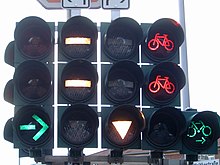Public transport priority
As public transport prioritization (including priority control ) is the preference of trams , buses or other public transport at traffic lights referred to in relation to the private transport.
Purpose and technique
The preference for public transport vehicles over individual transport is based on the assumption that, at the same time as a green light phase, public transport transports more people than is possible for individual transport. Consequently, it makes more sense to prefer public transport. As a side effect, it can be assumed that local public transport achieves faster throughput times and greater adherence to schedules, thus increasing the attractiveness of the offer and reducing the need for subsidies. This is offset by possible but not always occurring disadvantages for private transport: shortened green phases or more irregular color changes, possibly also a prolonged backlog. Sometimes the introduction of priority switching is more of a political decision: By giving preference to local public transport, the municipality emphasizes its will to give it a competitive advantage as the ecologically more favorable mode of transport.
Vehicle registration systems are a prerequisite for any public transport priority: The control of the traffic light system must be able to register the approach of trams or buses. For this purpose, loop / line systems are used, for example, in which information is sent from a transmitter in the vehicle to an antenna loop laid in the roadway, the receiver. Other transmission options are beacon / radio systems, infrared systems, inductive signal transmission and overhead contact lines . The information transmitted can include line number, direction of travel and delays. It is desirable to register the trams or buses as early as possible in order to give the signal system control sufficient "reaction time".
A distinction is made between absolute prioritization and conditional priority: With absolute prioritization, local public transport enjoys unrestricted priority over other road users; the flow of traffic is similar to that at a level crossing . In particular, at larger road crossings, only a limited priority can often be achieved, since the interests of the other road users must be taken into account here and usage conflicts between different public transport vehicles can also arise. In these cases, there are several options for reducing the waiting times for public transport vehicles by changing the signal schedule : Signal phases can be shortened or lengthened, the signal schedule can be interrupted for a demand phase, or signal phases can be swapped. A demand phase that is only activated when a public transport vehicle actually approaches reduces the average waiting time for other road users.
The time island is a special form of priority for local public transport : the temporary blocking of individual traffic by a signal system in the area of a tram stop that is not in a lateral position without a stop island enables passengers to get on and off safely.
Another special form is the bus lock : It can be set up at bus stops or at the end of a bus lane . A second traffic light is set up at a distance of at least 30 meters from the intersection; the space in between serves to thread the city buses in front of the individual traffic.
Public transport priority facilities can also be used to ensure the priority of police and fire engines in use.
application
Local public transport did not benefit from the green wave , which was widely introduced in the 1970s : The necessary stops at bus stops prevented people from “swimming” in time with the green wave, which is geared towards car traffic; in extreme cases, regular red phases for local public transport in addition to the bus stops can result be. Stops set up in front of the intersections have a particularly unfavorable effect. The tram, which starts with the rest of the traffic when the junction at the back is cleared, reaches the next traffic light system in a green phase, but it ends during the passenger change and forces a full round of waiting time. An alternating arrangement of the stops before and after the intersection areas can ensure that the tram can drive through every second section of the route without waiting, even if there is a green wave.
Individual cities such as Basel for the local tram used extensive measures to give priority to local public transport as early as the 1970s. The priority for local public transport in the context of increased environmental awareness was only used more widely in the 1980s. The planning of such measures was occasionally accompanied by local political disputes, in which the interests of the various users of the street space were reflected. Even today, priority is given to local public transport, which varies from city to city.
For the transport companies and the passengers, the preferential treatment of local public transport has advantages: Better calculable waiting times in front of the signal systems increase the punctuality and thus the reliability of public transport. Often the speed of travel can also be increased, which reduces the travel time for passengers; This means that in individual cases the number of vehicles used can also be reduced or the existing vehicles can drive at a faster pace, which in turn benefits the passengers. Better utilization of the vehicles in turn reduces costs, which can optionally be used to relieve the public coffers, lower fares or expand the range of services. In the last two cases, there may be additional demand for the now more attractive offer, which in turn improves profitability.
Signals
There are basically several types of signals (also known as bar signals ) to be distinguished. A signal, often the capital A (for request ), indicates that the traffic light system has detected the vehicle. There is also the clearance signal T (close doors, in some cities like Berlin also as a "Z" version for train clearance ), the permission signal, which corresponds to the traffic sign give way (in Germany sign 205), and finally the driving signals, the duty to stop or Show driving license.
Driving signal: Drive released in compliance with the turning rules in accordance with § 9 StVO
Individual evidence
literature
- Werner Schnabel, Dieter Lohse: Basics of road traffic engineering and traffic planning. Volume 1, 2nd edition, Verlag für Bauwesen, Berlin 1997, ISBN 3-345-00566-2 .








